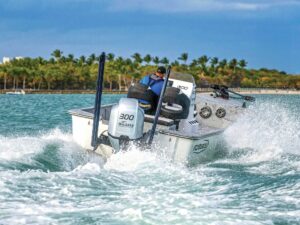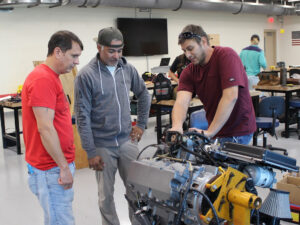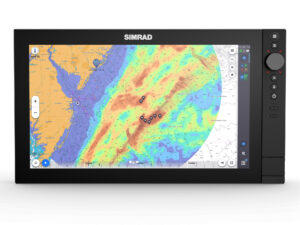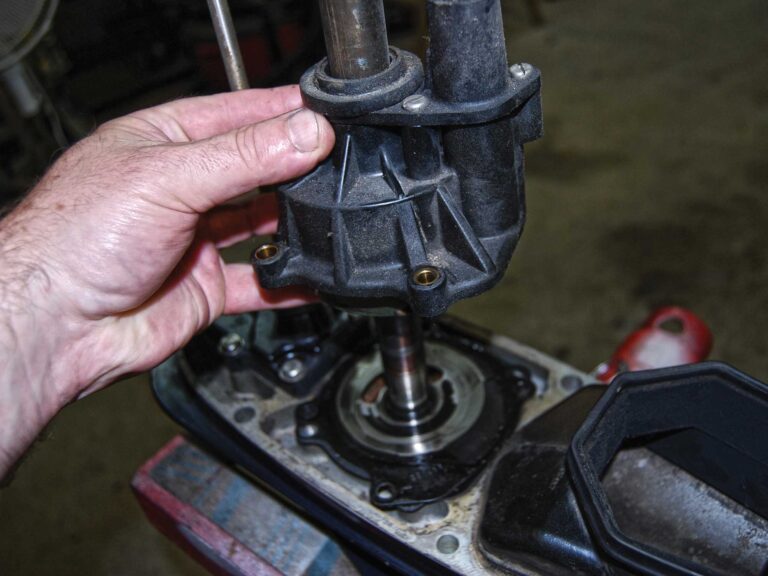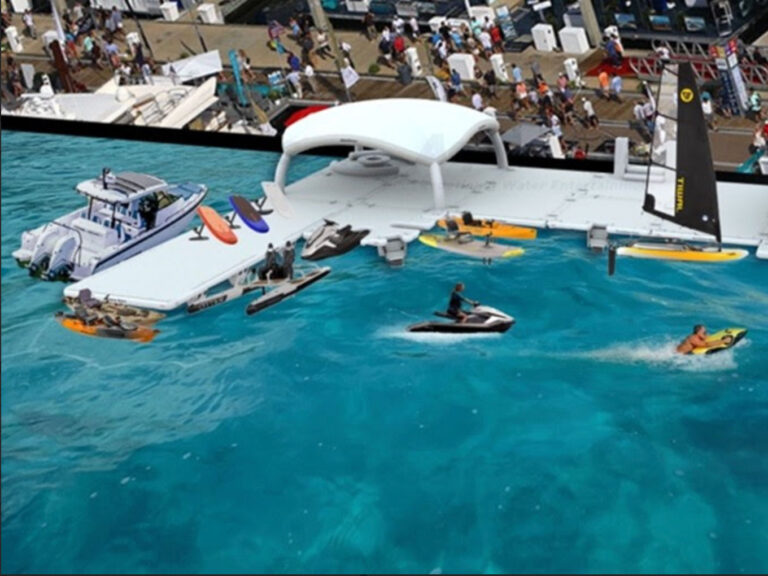
YOU MAY ALSO LIKE:
Bowfish Boat Construction and Design
Among fishermen and hunters, there has been a slow tempest brewing with a white-noise hiss that barely catches the ear of the unconcerned. It came to my ear one afternoon as I channel-surfed past the hunting and fishing shows on television, and then backed up a couple of clicks on the remote. Men stood on a huge flat-bottom jon boat, wearing olive drab and camo, with a platform at the bow from which they launched solid, white fiberglass arrows into the water. These angling archers hauled fish after fish on board, all skewered on a solid fiberglass shaft tied to a the end of a string.
I saw a boat like this recently and assumed it was for hunting Florida gators — and it could well do that too — but I soon learned this boat type actually signaled the lighting of the fuse to an explosion of lights, boats, archery tackle and prize money — all from fishing with a bow and arrow.
A recent Bass Pro Shops catalog had one such bowfishing boat — a Grizzly 2072 MVX. And for goodness sake, I saw archery equipment in the fishing catalog.
With my interest piqued, I called Katie Mitchell, public relations manager at Bass Pro Shops. “What are the chances you could hook me up with a good bowfisherman who could show me how this game is played?”


An understanding of this phenomenon is important to bow hunters, anglers who might want to sight-cast to fish, and, in fact, to all shallow-water boaters. Avoiding what you can see is often more important than connecting with it — just ask any boater who might be probing a flat or may have wandered off course into a shoal area. – Kevin Falvey Bass Pro Shops/Chris Irwin

Rig and Roll
A few months later I found myself standing at the archery counter of Bass Pro Shops’ flagship Outdoor World in Springfield, Missouri. Tabitha and Greg Schlicter from Texas were milling about there too, pointing and speaking softly about the archery equipment hanging on the racks — bowfishing gear, to be exact. They had decided to get into the rapidly growing sport.
“We’ve gone gigging,” Greg said, the practice of spearing fish with a barbed-fork point, “but bowfishing is a first. We’ve never shot a fish before.”
“We’re moving to Corpus Christi,” Tabitha chimed in. “We’d go there fishing and see all these sheepshead along the water, but they never bite. So we’re gonna shoot them!”
But that’s not why most people are getting into it. At the counter, the archery tech named Ryan, a St. Louis transplant, was setting up a bow for another couple.
“Can you tell me what’s up with bowfishing?” I asked.
“There’s fast action, a lotta fish and not much regulation,” he replied. “Back in St. Louis, that’s all they’re doing. Asian carp and gar are taking over the rivers.”
I took a closer look at the bows and wondered what I was in for.
The New Quarry
Asian grass carp are an invasive species, once imported to the U.S. and bred as sterile grass and algae eaters. One or two in a large, algae-infested pond could restore the water to clarity in a matter of weeks, which is why they were in demand. But floods along the rearing ponds near the Mississippi river system accidentally released the nonsterile breeding stock into the river tributaries, and the infestation of all U.S. waters throughout the Louisiana Purchase is now unstoppable. Today, by some research estimates, these waterways and much of the U.S. have as much as 80 percent of their biomass made up of various carp species, all of them non-native and destructive to native habitat. One national park service website indicates the carp infestation is so hopeless we should just learn to appreciate them. And it now looks like bowfishermen are.
“Where I come from, there’s so many carp, that’s all fishermen are doing,” Ryan explained while putting a final tweak on a customer’s bow. “It’s a heck of a time shooting these things.”
Garfish are another matter. These prehistoric natives have no natural-born predators except man, and, because of their nearly impenetrable plate-armor skin, you need tin snips to relieve them from their fillets. Their numbers multiply, nearly unchecked by anglers, and they eat other, more favored fish. These are the other primary targets for bowfishermen.
I think I heard somebody describe the action as “pandemonium.”

Creating Competition
For those most afflicted with this adrenaline rush, there is the Bowfishing Association of America. Among other things, BAA keeps track of world-record kills, like the 244-pound-8-ounce alligator gar shot by Robin Parks of Texas in 2005. Another boat-sinking trophy, a 92-pound-8-ounce big-head carp, was shot by Darren Opel in Illinois.
Want more thrills? Add competition to the mix. There were always bowfishing tournaments, but not to the standards set by Bass Pro Shops’ U.S. Open Bowfishing Championship. Boasting $25,000 in cash prizes, the promise of bowfishing fame, and a roster of fish-shooting celebrities to sign autographs and give shooting tips, the tournament should inspire newbies to jump in whole hog.
In fact, one such fellow goes by the nickname Pig Man, not for his demeanor, but for his habit of using a bow and arrow to take down wild hogs (as equally destructive to habitat as Asian carp). Pig Man soon nocked his arrows for porky carp and shot them with such regularity that his seminars made the marquis of the world’s first Bass Pro Shops Bowfishing World’s Fair.
My Turn
After my introduction at Outdoor World, I wanted to have my crack at these records — but I hadn’t pulled a bow string in at least 15 years, and the last time I shot a carp was in 1972 on the Lake of the Ozarks with a laminated recurve bow trailing what we called “trotline string,” a nylon cord stout enough to moor a small boat. The arrow bounced off and the carp cut a wake, speeding away.
I’d remember that experience during my hunt with John Paul Morris, founder of the U.S. Open Bowfishing Championship and the inspiration behind a new line of factory-rigged bowfishing boats — and a new brand of bowfishing tackle under the name Archenemy. And, yes, he’s the son of Bass Pro Shops founder, Johnny Morris, and a fair chip off the old block with the capable knack of spotting trends in outdoor sports. He was the pro Katie hooked me up with.
At a ramp on Stockton Lake about an hour west of Springfield we launched Tracker Marine’s special Grizzly 2072 MVX bowfishing boat and pulled away from the dock. Under the red glow of last light, my assigned bow glared in lime-green camo, bright enough so the guys could keep track of where it was pointing, even in the dark.
John Paul propped our bows, arrows nocked, across the top of the only aftermarket accessory we needed: a Rubbermaid garbage can that served as creel and quiver. My bowfishing reel, studded to the front of my bow below the arrow nock, was a technological leap from the tapered spool I once wound my trotline string around. This was like a push-button Zebco fishing reel with a wider opening for the line. The line wasn’t the mono used for fishing nor the trotline string that trailed my old arrows. This was more like dental floss, and when I first loosed an arrow, it felt as if it weren’t even there. The arrow flew as fast and true as … well, as true as I could shoot it.
We wound through the labyrinth of the Corp of Engineers impoundment for 15 minutes or so — about enough time for me to have lost my way — and eased into a cove, dropping off plane. Big Al (that’s all he offered as a moniker), our helmsman and shooting partner for the night, snapped a switch, and the battery-powered LED lights immediately flooded the cove, making the surrounding Ozark hardwoods as brilliant as a theater set. The lights ran on batteries for a time, and then Big Al would yank the 12-volt genset/charger cord to give them new life. Our stage of operations was literally a stage. The shooting platform was nearly 9 feet square and about 3 feet above the helm deck of this 20-foot flat-bottomed jon boat.
Turns out, John Paul had a strong hand in the design, and Tracker Marine worked to broaden the bow to add 10 inches to the shooting deck. A low rail around it reminded my feet of the edge. There were cup holders in a leaning rail aft with more quivers for extra arrows. An electric trolling motor guided us along. Sometimes we’d just motor in on the Merc outboard. “Sometimes you can fill that barrel pretty fast,” John Paul said.

Why They Call It Hunting
We eased along in the cove, and the only fish we saw skittered out from under us before we could let an arrow fly. So we slipped into the next cove, this time moving ourselves along only using the near-silent electric Minn Kota.
Our targets could be silver carp, big-head carp, buffalo or black drum, the latter being the only other native freshwater species besides gar still considered a rough fish and a fair target for archers.
Standing on my left, John Paul drew, unnoticed by me, and let an arrow fly. Our photographer, Chris Irwin, yelled out “great shot!” An arrow pinned an Asian carp, and John Paul cranked it in and, after being photographed, shook it into the Rubbermaid.
That raised the question: What would one do with a barrel of these fish? Turns out, Bass Pro Shops made sure that question had a responsible answer.
First, they really aren’t bad to eat. The problem is usually small bones. Many anglers fillet the carp, chunk the fillets, and then score the meat (make rows of thin cuts not quite through the chunk) to cut the fine bones in small pieces that seem to cook away in frying. If you can skin a gar, do the same to its meat.
Most cooks fry them hot and fast in an outside cooker. How do they taste?
“Like crappie,” John Paul said. “They’re pretty good.”
But there are other ways of ethically handling these fish.
“At our tournament we have a company waiting to collect the fish and convert them into organic fertilizer,” John Paul said. “We’ve taken them to turtle farms too.”
I took the bow for the next few shots.
“Shoot low. Light refraction will fool you,” John Paul said.
What I found after four or five near misses is that an aim pointed a few inches below the head would usually get the arrow close to a body shot, though John Paul seemed to be bagging them with a head shot. For me, you have to pick a spot, like a gill plate or an eyeball. If you just aim generally at the fish, you’ll miss. They’re a slow-moving target until the arrow breaks the water. Then they rocket forward, confounding the best archers.
Finally, after all those misses, I lined up the arrow and when I released, it stayed true. Soon I hoisted my first kill, a smaller one than John Paul’s, but heck, it was a hit. And the only record we wanted was an exciting experience and photos to remember it.
When we had five or six fish in the barrel, one of which was mine, we shut the motor down and drifted up against a log. The air was beautiful, the night clear and, with the motor and genset off, silent. Fish splashed in the distance, and a great blue heron squawked in the tree above, relaxing as we quieted down. We talked in low tones of why the fish seemed more elusive tonight — maybe fronts or the waxing moon. We talked of African hunting, goose hunting in western Missouri’s flyway, turkey hunting in the spring and bowfishing.
I thought about whether I could add a third boat to my fleet and maybe a new bow. And I decided that night, it would be the turtle farm for our quarry.

